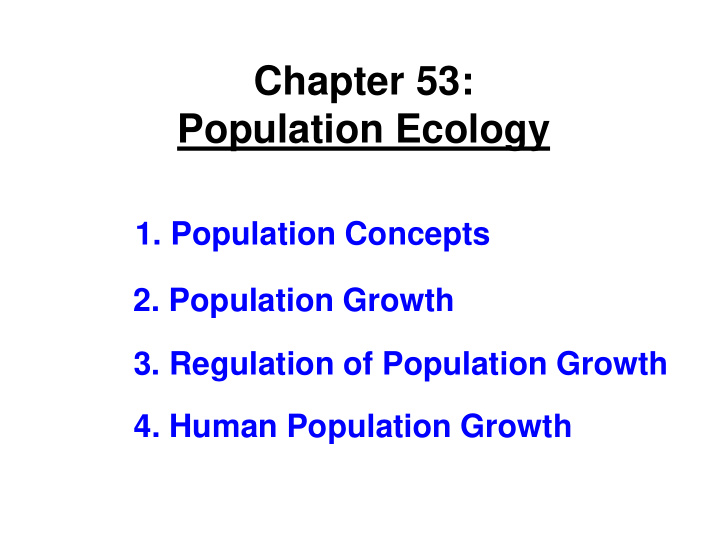



Chapter 53: Population Ecology 1. Population Concepts 2. Population Growth 3. Regulation of Population Growth 4. Human Population Growth
1. Population Concepts
What is a Population? A population interbreeding group of the same species living in the same general area: • populations may be distinguished by natural boundaries (e.g., an island population) or arbitrary boundaries (e.g., California population)
Population Density The density of a population is the number of individuals per unit area or volume. • e.g., number of humans per square mile or number of bacteria per milliliter Population Dispersion The dispersion of a population refers to the pattern of distribution of individuals within the boundaries of the population. • e.g., uniform, clumped or random dispersion
Patterns of Dispersion * territoriality leads to * most uniform dispersion common
Population Dynamics Populations are dynamic, not static, and change in density, dispersion and total numbers due to:
Demographics Demographics is the study of vital statistics in a population, primarily birth & death rates, and how they change over time. A Life Table is a useful way of summarizing vital statistics.
Survivorship Curves Survivorship curves are a plot of the number of live individuals vs age or life span and reflect reproductive strategies: I – Fewer offspring and low mortality until old age due to parental care. II – Death rate is relatively constant throughout the life span. III – Many offspring & high mortality in young due to lack of parental care.
Semelparity vs Iteroparity Some species reproduce once in their lifetime (semelparity), typically leaving large numbers of offspring, most which die: • e.g., salmon or agave • e.g., offspring are “on their own” Other species reproduce repeatedly in their lifetime (iteroparity), typically leaving small numbers of offspring, most which survive: • e.g., humans, elephants • offspring are cared for
Reproductive Rates • demographers generally focus on females when studying reproductive rates since only females produce offspring • reproductive tables summarizes reproductive rates in relation to age
2. Population Growth
Population Growth Rate Ignoring immigration and emigration, the change in population size over time is: Change in – population Births ( B ) Deaths ( D ) = size per unit time ( D N/ D t ) Births and Deaths can also be expressed as the average number of births and deaths per individual (per capita) per unit time (e.g., per year): • e.g., if 50 births per 1000 people per year, annual per capita birth rate = 50/1000 or 0.05
…more on Growth Rate Thus the growth rate of a population can be calculated as follows when per capita birth rate = bN and per capita death or mortality rate = mN : bN – mN = D N/ D t rN = • if bN > mN , the growth rate is positive • if bN < mN , the growth rate is negative • if bN = mN , the the growth rate is zero bN – mN can also be expressed as rN (the rate of increase), thus the value of rN indicates whether a population is growing, shrinking or at equilibrium
Exponential Growth If r is steady and positive ( r inst ), a population will grow exponentially. • under ideal conditions the growth rate will be maximal ( r max ) and growth will also be exponential
J-Curve Growth Exponential growth is also called “J - curve growth” due to the shape of the curve. • J-curve growth occurs when populations are small and resources plentiful • J-curve growth cannot be sustained indefinitely…
Logistic Growth Model The habitat in which a population lives can support a maximum population size – the carrying capacity (K) – above which the population cannot grow sustainably • the carrying capacity is responsible for logistic or S-curve growth in which the growth rate decreases as the carrying capacity is approached due to environmental resistance … • logistic growth can also be expressed mathematically: r inst N x (K – N)/N) = D N/ D t
Logistic Model & Real Populations Sometimes the growth rate of a population will not be purely logistic and overshoot the carrying capacity followed by an adjustment period eventually settling near the carrying capacity.
3. Regulation of Population Growth
Environmental Resistance All factors (biotic & abiotic) that limit or resist population increase Density-dependent factors: • environmental resistance factors that change in response to population density • usually biotic (predators, disease, lower food supply) • decrease birth rates and/or increase death rates closer to the carrying capacity Density-independent factors: • resistance that is unrelated to population density • usually abiotic (changes in weather, fire,…)
Density Independent vs Density Dependent Growth
Density Dependent Factors
Population Dynamics Population sizes can fluctuate widely over time due to changes in environmental resistance (weather & climate, predator population size, pathogens)
4. Human Population Growth
The Human Population Explosion
Why the Population Explosion? Decreased environmental resistance (i.e., decreased “death rate”) due to: • protection from disease (loss of predators?) • better nutrition, hygiene • improved food production *Has little to do with changes in fertility rates* • average # of children per woman is ~ the same
Human Growth Rate is Decreasing Even though the human population is increasing, the rate of increase is lowering. Why? Largely due to the Demographic Transition …
The Demographic Transition The populations of developed countries have all undergone a transition from: • high birth & death rates • high birth, low death rates (population expansion) • low birth, death rates Developing countries are predicted to follow a similar demographic transition
Age Structures Age structures are very useful for predicting future population growth:
Ecological Footprint by Region • surface area required to sustain each person (at current levels of consumption)
Worldwide Energy Use
Recommend
More recommend